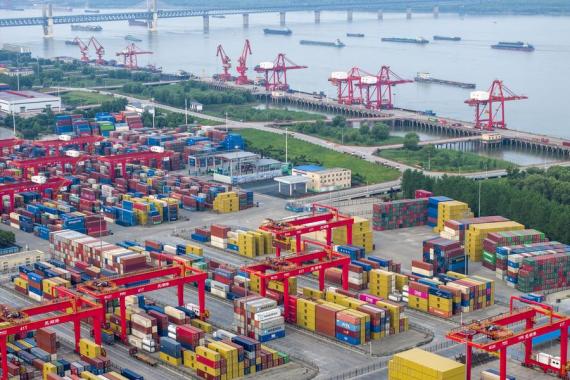China’s Trade Resilience: A Look at Future Prospects Amid Global Tensions
Amid escalating global trade tensions, experts anticipate that China’s foreign trade will continue to display positive momentum in the coming months, largely due to the country’s strategic export restructuring initiatives. This outlook was discussed during a recent webinar by the China Macroeconomy Forum, where leading economists shared their insights on China’s trade resilience and future prospects.
Positive Projections Amid Challenges
Yu Xiangrong, chief economist at Citigroup China, projected that the country’s export growth would remain stable at around 5 percent in 2024 and 4.5 percent in 2025. These forecasts come on the heels of impressive performance metrics, with goods exports rising by 6.1 percent year-on-year and goods imports climbing by 6.4 percent in the January-May period.
“Looking into the second half of 2024 and the next year, we remain cautiously optimistic about China’s export outlook,” Yu stated. He underscored several encouraging factors that highlight China’s trade resiliency despite the global wave of protectionism.
Shifting Trade Dynamics
China’s export strategy is increasingly shifting from developed markets to emerging ones. This change is in response to anticipated declines in demand from developed economies, which are grappling with tepid economic growth. In contrast, regions like ASEAN, Latin America, BRICS nations, and other Global South trading partners are expected to “fill this gap.”
Sheng Bin, vice president of Nankai University, echoed these sentiments. He emphasized that China should focus more on emerging economies, given the weakening demand and rising debt issues in Western economies.
Strengths in Manufacturing and Technological Advancements
China’s trade progress is attributed to its robust manufacturing capabilities and advances in technology. The country has built comprehensive supply and industrial chains, positioning its exporters to gain cost advantages through industrial upgrading and open competition.
Yu pointed out that even with the prospect of the EU’s provisional tariff hikes on Chinese electric vehicles (EVs), Citi’s calculations indicate that Chinese EVs still retain a cost advantage, which will sustain export momentum in the sector.
Liu Yuanchun, president of Shanghai University of Finance and Economics, remarked that China’s export sector is more cost-effective than its U.S. counterpart in manufacturing a wide range of goods, including electromechanical and high-tech products. This efficiency is bolstered by technological advancements and the scale effect.
Concerns and Trade Tensions
Despite these positive signals, there are growing concerns about intensifying global trade tensions, especially with the EU’s plans to impose additional tariffs on Chinese EVs. The European Commission recently disclosed a plan for provisional tariffs ranging from 17.4 percent to 38.1 percent on imports of Chinese EVs, a move criticized as protectionist by many market watchers and China itself.
Adding to these tensions, the United States recently announced tariff hikes on a variety of Chinese imports, including EVs, lithium batteries, photovoltaic cells, critical minerals, semiconductors, steel, and aluminum.
“Trade policies of the advanced economies are prominent sources of uncertainties ahead, which need to be monitored closely,” Yu said, emphasizing the importance of boosting domestic consumption and unblocking internal economic circulation to maintain stability.
Future Strategies
Looking ahead, experts at the webinar suggested several strategies to sustain and enhance China’s foreign trade. These include expanding trade in intermediate goods and promoting the digital economy to foster new growth drivers.
Conclusion
In summary, China’s foreign trade is poised for continued growth, driven by strategic shifts in its export structure and resilience amidst global protectionist trends. However, vigilance is required to navigate the uncertainties posed by international trade policies and geopolitical conflicts.
